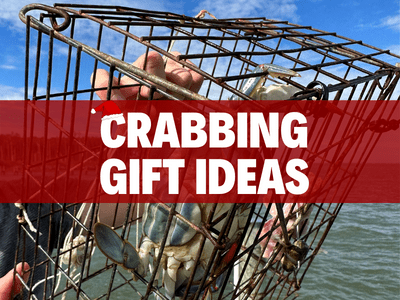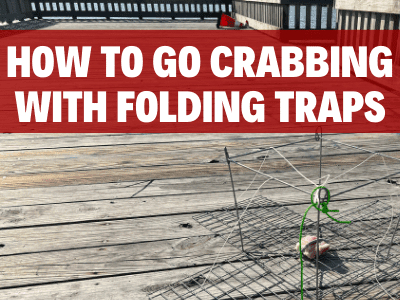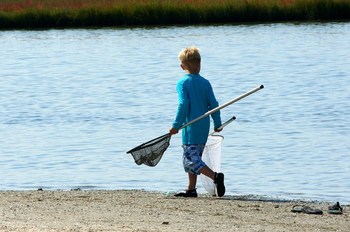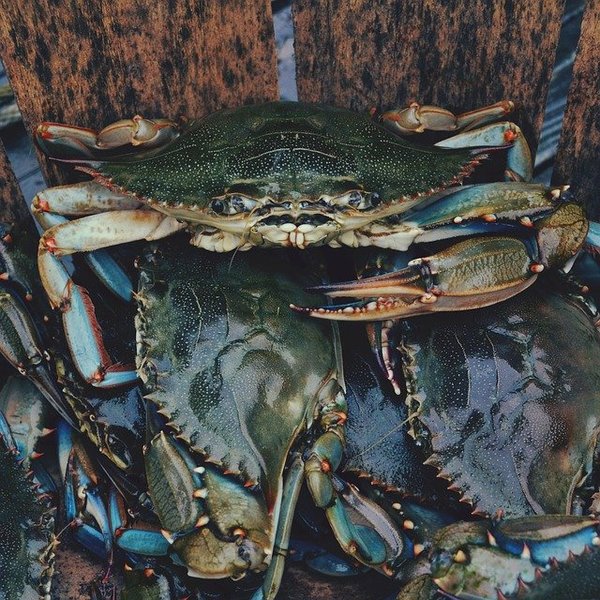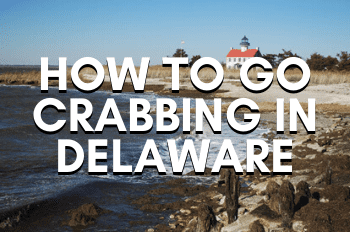Crab Snaring: The Complete Guide
Crab snaring is an art that takes not only patience but skill and practice to pull off. It’s a very popular way of crabbing along the west coast because of the reigon’s delicious Dungeness Crabs and their gigantic claws. You’ll also find some veteran crabbers using crab snares to catch Blue Crabs along the Atlantic and Gulf Coast.
Let’s take a look into the sport, how to get started, as well as some tips and technique to help you catch a crab.
With the Holiday Season coming around, I put together a gift guide for anyone who loves to go crabbing. I was tired of generic crabbing gift ideas with a graphic of a crab on a mug or t-shirt. Instead, I wanted to make a list of what a crabber actually needs and will end up buying themselves.
If you’re interested, read my article: Gifts Ideas for Any Crabber (Items they’ll actually use!).
What are Crab Snares?
To most crabbers on the East Coast, a crab snare is some foreign device many of us haven’t even heard of before. To put it simply, a crab snare is a small cage that holds baits surrounded by small loops. The trap lures crabs with the smell of the bait, and after 10 minutes or so the fisherman reels in the trap with his or her fishing rod. As the trap is reeled in, the snare loops will close around any claws an unfortunate crab might have between them. If you’re fast enough and keep enough pressure on the line, the crab will not have any time to think or try to scurry away.
As mentioned before, it’s a popular trap to use on the West Coast in states such as California, Oregon, and Washington. The crabs there are much larger and It’s easier to loop around a Dungeness or Rock Crab claw rather than a tiny Blue Crab claw. If you’re on the West Coast, grab some snares and go crabbing! I envy you. If you’re on the East Coast like me, we’re going to have to do some extra research.
Let’s look into how to set up our fishing rods to catch both large crabs such as Dungeness and even smaller ones such as Blue Crabs.
Recommended Fishing Rod Setup
Crab snares are very heavy. The trap itself weighs about 5 ounces once you fill it with bait. You’re gonna add a few weights to the trap to keep it in place in heavy currents, so add another 6 ounces. Lastly, the crabs on the Pacific Coast can weigh up to 2-3 pounds, while crabs on the East Coast can weigh up to 1 pound.
To handle all that weight, you’re going to need a very strong rod, reel, and line.
Rod
Whether you’re crabbing for Blue or Dungeness Crabs, let’s assume that you’re going to be dealing with 3lb crabs at all times. This is a bit overkill for Blue Crabs, but just right if you’re crabbing anywhere on the West Coast.
Assuming you will be reeling in just about 5lbs, you’re going to need a very strong fishing pole. Whatever you use is up to you, but I recommend a pole at least 8-10ft long and can handle over 10lbs. If you’re crabbing for blue crabs it can be a bit less, but better safe than sorry.
A great choice is a 10’ Daiwa Beefstick. If you’re lucky enough you can sometimes find them on Amazon for around $30. Be sure to check your local outdoors store or bait & tackle shop, I’m sure you’ll find the perfect pole.
Reel
With every strong pole comes an even stronger reel. The weight of your snare and bait alone is about one pound, so we need something that won’t fail and allow us to cast our crab snare far out into the water.
I recommend at least a size 6000 reel, anything larger would be ideal. A good way to go is an 8000 size reel; it’ll go great with your 10’ fishing pole. The larger the size the easier it will be on your wrists to reel in those heavy crab snares.
There’s plenty of choices on Amazon and other online retailers such as Cabellas and Bass Pro Shop. A size 8000 reel may be a bit more expensive, but not as expensive and stressful as your fishing pole snapping and losing your precious crab snare. For several years I used a 6000 size reel and had no problems, other than some sore wrists at the end of the day.
Line
I bet you’re sick of hearing this, but crab snares are heavy. You’re going to need around 30-40lb rated line. Casting a whole pound of weight can put a lot of pressure on your line and potentially snapping it. With at least 30lb line, your rod should do just fine reeling in crabs and your trap.
Wherever you bought your rod and reel you will be sure to find fishing line. There are plenty of great choices at online retailers such as Amazon, Cabela’s and Bass Pro Shop.
I found the best prices for these items on Amazon.com.
To save you the time and effort of searching, I found the highest-quality items for a crab snare set-up at the best prices on Amazon. (Affiliate Links):
- A 10-foot fishing pole, The Daiwa Beefstick is the top recommended from crabbers.
- At least a size 6000 spinning reel, I recommend a size 8000 but it can get pricy. Anything smaller can’t handle the weight. Penn Pursuit is a reliable brand.
- You will need 30-lb braid fishing line. Anything less will snap!
- Last, but not least, a crab snare. Airfly sells the best snare on the internet, and I’ll explain why.
Crab Snare Buyers Guide
Crab snares are impressive little mechanisms, which have three main working aspects I believe to be very influential in their ability to catch crabs. 1 it needs a durable cage, 2 functional snares, and 3 a shape that smoothly glides through the water.
Buy or DIY?
Let me be honest with you. Most of the crab snares you find on Amazon or most outdoor supply stores are terrible. The main issue is the loops- they’re cheap and poorly made.
The only widely-sold crab snare that I’ve heard great things about is the AirFly Custom Made Crab Snare (Amazon Affiliate Link). They heard the cries of crabbers left with low-quality crab snares. They created a product with not only a high-quality cage but also high-quality loops to go along with it. These loops, unlike the snare I bought, stand straight up. Let’s go over why that’s important.

Crab snares work best when the loops are facing upwards. When the loops are upright and vertical to the riverbed, a crab is much more likely to get its claw snagged in the snare. With most crab snare brands the loops lie flat on the ground. You might as well toss your bait in the water and call it a day because you won’t catch any crabs.
Don’t get me wrong, some snares are okay. You’ll find a few keepers here and there, and most snares have very well-made cages to hold your bait. I bought the Danielson snare off Amazon for $12.00, and I’m happy with the purchase. The cage is rubber-coated mesh and does a great job standing up to crab claws.
The only problem was the loops, they laid flat on the riverbed as the crabs munched away at my bait. It wasn’t until installed new loops that I caught my first blue crab. Watch the video below and see how Matt from Fisherman’s life made amazing snares for his crab snare. They were designed for Dungeness Crabs; if you’re going after Blue crabs you will need smaller loops.
If you’re pretty handy and up for the challenge of making a crab snare, I highly recommend it. They work much better than any store-bought snare and catch crabs better too. Watch the video below for an in-depth explanation of how to build a crab snare.
The crab snare Matt from Fisherman’s Life makes is designed mainly for Dungeness Crabs. If you plan on catching Blue Crabs, you will need smaller loops.
Above is a great snare design for blue crabs. The only thing I would fix is how the loops seem to lie on the ground. Perhaps some thicker loops would do a better job. If that fails, try looping the snares through the cage in the same fashion shown in Fisherman’s Life video on how to make a crab snare. He loops them so that they stand up on their own, which is the recipe for success in using crab snares.
I also like how the blue crab snare design has a wire that stretches away from the loops to connect your fishing line to. This is very handy so that your fishing line doesn’t get caught in your snares.
Rigging Your Crab Snare
Now that you have the perfect fishing pole built and ready to go, along with a few handy crab snares (I recommend bringing at least 3 on a crabbing trip), we can rig them to catch crabs.
First, you need to attach your fishing line to your crab snare. The snare will either have a long wire sticking out from the cage to tie your string to or simply a small ring. Either will work, but I prefer the wire to as it prevents tangled messes.
I recommend that you use the surgeon’s knot:
Make sure you attach the fishing line to the top part cage thats opposite to the part where you add weight.
Adding weight to your line is just as easy. For rougher waters I recommend 3oz to 8oz, depending on how much your fishing pole can handle. You need your trap to lay flat on the sea floor, which makes a
There’s two ways you can add weight to your trap: attach it directly to the cage or use a pyramid weight.
I prefer attaching the weight directly to the bottom of the cage. It’s easy to do with a few zip ties and a few long weights that line to the bottom of your cage. You can skip the headache and simply throw the weight inside the cage with your bait.
Using a pyramid weight is a bit more difficult. You will need to attach your preferred oz weight (3-8oz) to the bottom side of your snare opposite to where you tied your fishing line. Fishing line can easily snap, so I recommend using small dual-lock clips as they’re cheap and don’t get tangled as much with the snares. Simply clip one end to your cage and your weight on the other.
The pyramid weight works a little better because it works as an anchor and digs into the sand, but whatever you use is up to your preference.
Lastly, and I would save this for when you get to the water, is to bait your trap. Make sure you bring fresh bait the crabs will love (any oily meat such as chicken or fish will do just fine) and plenty of it! I wrote an article on the best crabbing bait, feel free to check it out here.
Your snare should have a small band or clip that opens and closes the hatch to the cage. Stuff the snare full of bait and maybe a little extra scent you can buy at any bait & tackle store. Your goal is to put a strong bait smell in the water for your crabs to find your snare. Also, you don’t want them to run out of food to eat. A cage full of bait should last long enough for you to snare some crabs.
Perfect Crabbing Conditions
Now that your snare is set and you’re ready to go crabbing, you need to know when. A lot of factors determine success with crab snaring, and the weather is a big one.
The number one rule is to go crab snaring when the water is calm. Fast currents, rough waters, and large waves make it much harder to catch crabs.
Large waves and strong winds can make your line bounce, which pushes and pulls your snare in the water, which can repel and confuse crabs trying to eat your bait. If you decide to pull in your bait while they’re trying to chase down your runaway snare, you’ll likely not catch a thing.
Large waves can also leave slack in your line as you reel it in. The last thing you want is slack in your line, as it loosens the snares and frees any crabs who might be stuck in them.
The perfect conditions to use crab snares would be a calm, sunny day with low winds and an easy current. Waves need to be at a minimum to make reeling in your crabs an easy task.
I highly recommend that you read your local area’s tide charts, as they give great insights into how the water will be that day. https://www.tide-forecast.com/ has tide charts of pretty much everywhere, worldwide, at all times. It’s a great resource for anyone going fishing or crabbing.
As you read the high and low tides for each day, do a bit of simple math. Find the difference in feet the water recedes/advances between high and low tide. The greater the difference, the greater the current will be that day.
Your goal is to look for a day that has both great weather and a small current.
Another aspect to take into account is the physical features of your crabbing spot. Before you throw your trap in the water, make sure its sandy and flat. It is really easy to get your crab snare caught on seaweed, rocks, or any other obstacles found on the riverbed.
It’s good to know your crabbing spot. Anywhere you know that meets these conditions and has crabs should do fine. If not, ask around or check online, you might be surprised by what you find out.
Technique
Now, let’s look into how to use a crab snare. By now I’m sure you understand the general gist of it. Simply cast a crab snare into a sandy area with lots of crabs, wait about 10 minutes, then reel it in. It’s basically a more difficult version of a ring net, but much more satisfying for catching a crab.
You will want to be somewhere relatively shallow, and almost level with the water. A beach or low–lying pier will do just fine. As mentioned before, make sure the water is free of seaweed or rocks and mostly flat and sandy.
Casting
I’m assuming you know how to cast a fishing rod, if not check out this WikiHow article.
I’ve picked up a few great tips after watching the Youtube Channel Fisherman’s Life. With their video on crab snaring, he showed us how to launch such a heavy crab snare without snapping your pole or hitting any unlucky bystanders.
The trick is to use the fishing pole like it was made to function. You need to use the pole like a spring to launch the snare out into the water.
A great trick is to let the snare bounce one time on the end of your pole. As it rises back up, you launch it overhead or to the side, which is up to your personal preference. Watch the video below for a visual.
Reeling it In
Let’s imagine you left your crab snare out in the water for 10 minutes or so, and you’re ready to reel it in. Without disturbing the snare, grab your fishing pole and get ready.
You’re going to pull as hard as you can until you cannot pull any longer, then reel in the line. This all has to be one fluid motion, any pauses can cause your line to slack and lose your crabs.
From there continue to reel in your snare. Keep constant tension on the line and never stop reeling it in. Try your best to avoid any jerking motions as you reel in the line to avoid loosening your snares.
Watch the Comprehensive Crab Snaring Guide (the video right above) at 7:36 for a perfect demonstration on how to reel in a crab snare.
Congratulations! You just used a crab snare. Once your trap reaches shore, let the crab hang from the snare. This will keep it tight and secure. Relieve pressure once it’s over land or a spot where you can easily measure and store your crab.
Crab Snaring Without a Fishing Rod
If you’re crabbing in relatively calmer waters, such as a river or marsh, this is a great option for you.
You can avoid the whole fishing rod mess and still catch crabs with a crab snare. It is just as difficult and requires plenty of patience and practice. I
You will set up the snare the same way, except for tying your snare to a fishing rod. I recommend trying it to the end of plenty of fishing line, which can be tied to a tree, stick, or anything that won’t get dragged into the water once you cast it. Depending on the depth of the water, you’ll want 50-100ft of line.
Casting is a bit different. It doesn’t matter how you launch your snare, only how far. You’ll want to get it in waters at least 2ft deep, where crabs like to hang out.
When I cast a crab snare without a net, I do so as if the snare was a rock in a sling. I let the snare be the weight and launch it from my side. Let the unravel file through your hand and make sure the end is tied to something strong and secure like a tree.
If you have any further questions leave a comment!

